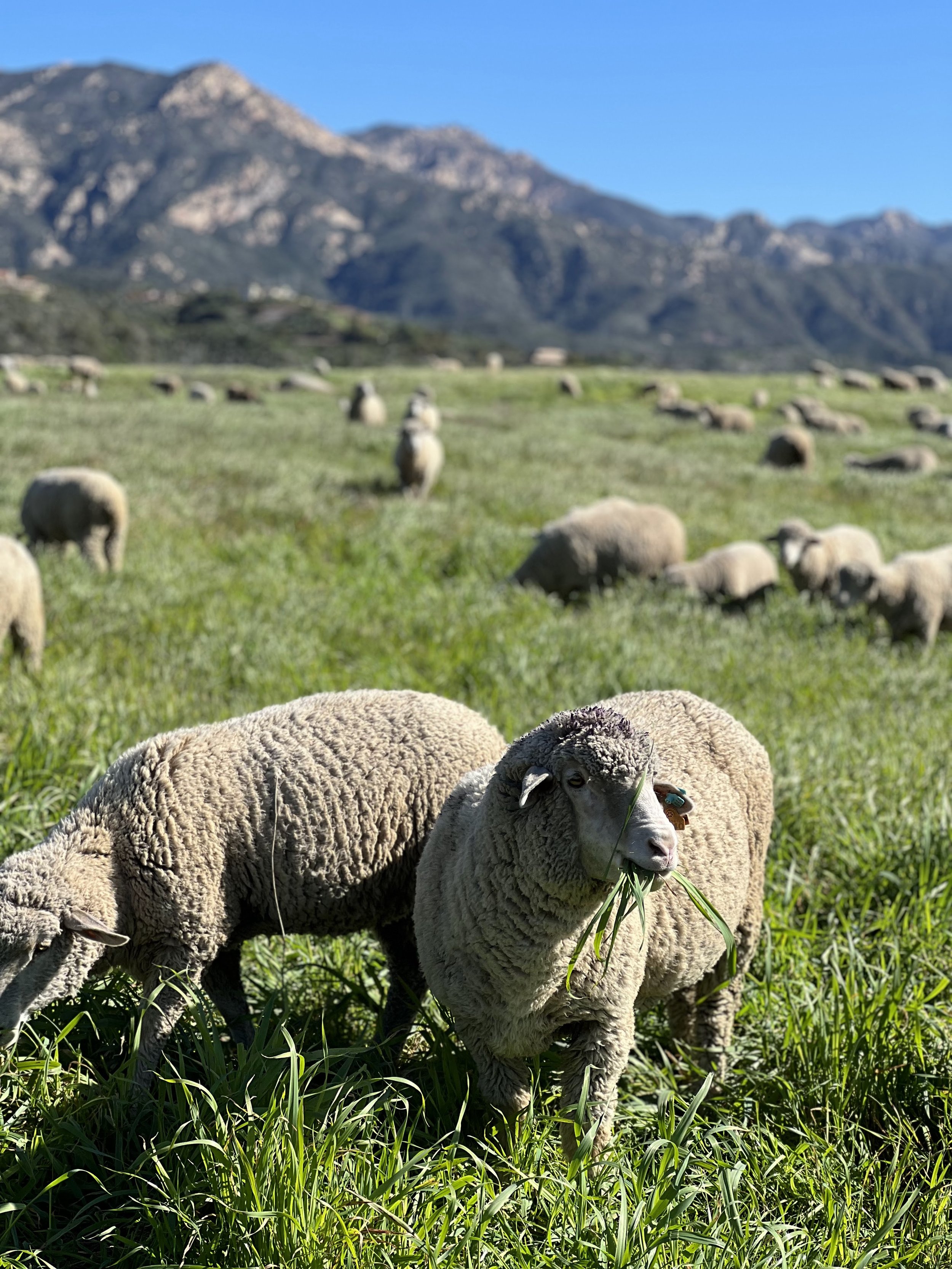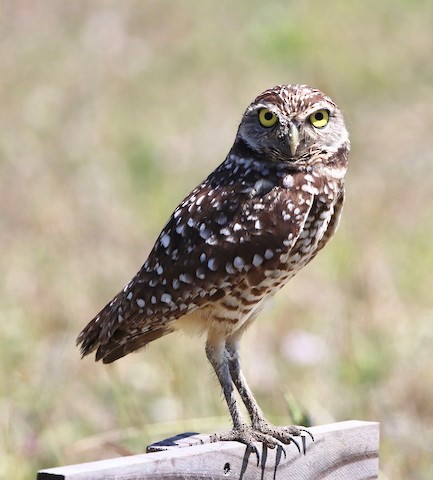Restoration of Native Grasslands & Bird Populations
Sheep Grazing on the San Marcos Foothills
Channel Islands Restoration (CIR) is conducting carefully prescribed sheep grazing to restore the native grassland at the San Marcos Foothills Preserve. Native grasslands used to inhabit millions of acres of California, providing nesting opportunities for birds such as the Grasshopper sparrow (Ammodramus savannarum) and the Burrowing owl (Athene cunicularia).
Now, very little is left. One place that native grassland remains is on the San Marcos Foothills Preserve, where it is dominated by Purple needlegrass (Stipa pulchra) the tall bunch grasses you see on the mesa. However, it is threatened by invasive grasses from Europe such as Ripgut brome (Bromus diandrus).
Although uncontrolled grazing has caused damage in many regions, carefully designed and timed grazing programs support the growth of native plants and reduce the number of non-native grasses.
Grazing also has an important effect on fire safety. In November 2018, the Cave Fire was extinguished at the San Marcos Foothills Preserve. County Fire Chief Rob Hazard credits CIR’s grazing program with saving the neighborhoods around the San Marcos Foothills Preserve: “By all accounts most firefighters were convinced the Cave Fire would burn into the developed neighborhoods in the North La Cumbre area and had the potential to result in significant structure loss. This did not happen, no structures were lost, and the primary reason was the buffer provided by the grazed areas in the Preserve.”
Please note, through July we have docent volunteer shifts that are available at the San Marcos Foothills Preserve. It's sheep season again at the San Marcos Foothills Preserve, we need your help to educate the public!
If you have any questions or comments about this program, please contact Ken Owen, at 805-448-5726 or Cuyama Lamb, at 805-881-1069 or 310-351-9233. Funding for this program is provided by Santa Barbara County Fire Safe Council. More community support is vitally needed for this program. Please donate at www.cirweb.org/donate.
Funded by the United States Fish and Wildlife Service Partners Program, the County of Santa Barbara, the California Department of Fish and Wildlife Office of Spill Prevention and Response (“CDFW/OSPR”) and the National Fish and Wildlife Foundation, and Channel Islands Restoration.
Above: Sheep graze at the San Marcos Foothills during the recent grazing cycle.
Photograph of the Cave Fire by Paul Wellman - In November 2018, the Cave Fire burned the area and was extinguished at the Preserve.
County Fire Chief Rob Hazard credits CIR’s grazing program with saving the neighborhoods around San Marcos Foothills.
CIR recognizes and wishes to remind us all that the beautiful land we all enjoy in this region is the unceded territory of the indigenous Chumash people. We respect their wisdom and commitment to the land and seek their advice and participation in our work. CIR is committed to fostering diversity and inclusion in the environmental movement, pursuing equitable outcomes in our work, and fostering a just and healthy environment for all.
Overview
The San Marcos Foothills Preserve is a 301-acre open space of rolling grasslands, oak woodlands, and shaded creeks. These types of habitats are important to our local wildlife, but they have largely been taken over by invasive weeds and urban expansion throughout California. The Foothills contain one of the largest grasslands in our area, but much of the preserve is dominated by non-native grassland species which greatly reduce the quality of habitat that these grasslands can provide - thereby reducing the numbers of species that can live on the Preserve.
Location
The Foothills lie at the base of the Santa Ynez Mountain range above Santa Barbara, just to the east of Highway 154 which winds its way up through the San Marcos Pass towards Lake Cachuma.
History
Tule elk were once common in the Santa Barbara area, but today are most commonly found in the Central Valley.
In the distant past, ground sloths, mastodons, wild horses, mammoths, and other pre-historic megafauna inhabited this region. Grasslands evolved alongside these creatures and adapted to not only be able to withstand trampling, grazing, and soil disruption, but to thrive and outcompete other plants for space and nutrients.
In more recent history, elk and deer were common grazers in the Santa Barbara area before being displaced when ranchers brought livestock into the Santa Barbara foothills. While grazing patterns of these managed livestock was not a perfect replacement for native grazers, cattle, sheep, and other livestock effectively filled a similar role to their pre-historic counterparts.
Livestock were taken off the Preserve in 2008, which was quickly followed by the Jesusita Fire of 2009 ( map ). The fire left much of the Preserve's grasslands open, allowing for quick-growing invasive annual grasses to establish themselves, without interference from grazers, and exclude native plants. Many of our native perennial grasses take the time to grow deep root systems that enable them to regrow after their above-ground parts are grazed. Conversely, invasive annual grasses are adapted to grow quickly after the first rain of the season, produce and drop their seeds, and then die off. After any sort of large disturbance (e.g., wildfires or mudslides), a thick mat of invasive grasses can grow quickly and inhibit the growth of any of our slower-growing native grasses. Today, much of the 50 acres of grassland on the Preserve is dominated by invasive non-native grasses, which form a thick homogenous thatch that excludes native growth, inhibits ecosystem nutrient cycling, and provides poor habitat for grassland-dependent birds and other wildlife.
Best Management Practices to Reduce Negative Impacts
Rotation: optimize grazing based on pertinent factors and objective
Exclusion: enclose stock, exclude from sensitive areas and resources
Monitoring: ensure grazing is proceeding as planned, monitor effects
Ongoing Research: of ecological grazing happening locally/regionally
Recent Grazing Results Visualized
Left: Green foliage consists of mostly non-native grasses on the Foothills.
Right: Native bunch grasses appear on the Foothills after non-native grasses have been removed.
Native perennial bunchgrassses like purple needlegrass (Stipa pulchra) still inhabit some parts of the Preserve.
Unlike our native bunchgrasses, non-Native annual grasses grow tall and thick - though sometimes native wildflowers like fiddleneck can grow among the non-natives.
Non-native annual grasslands dry out at the end of the rainy season, leading to dead grasslands devoid of nutrition while also creating a significant fire hazard.
There are also a number of native shrub communities on the fringes of the grassland that provide yet more habitat for birds and other wildlife.
Native wildflowers are an important part of the Preserve
Birds
As the quality of the grasslands has diminished, many grassland-reliant bird species have declined in presence to become uncommon visitors or not present on the Preserve at all.
Important Grassland Birds on the Preserve
Click each bird to learn more
Raptors on the Preserve
Habitat Restoration Goals
Primary Goal
Restore populations of grassland-dependent birds on the Preserve by restoring 50 acres of grassland to native perennial grassland.
Secondary Goals
- Ecosystem: Create and sustain habitat for common and special-status species.
- Water: Increase the amount of water that is stored under ground and slowly released and decrease runoff.
- Climate: Increase ability of animals to survive effects of climate change. Increase carbon sequestration.
- Culture: Provide opportunities for permitted native peoples for the gathering of native plants.
- Recreation: Provide public access.
- Participation: Provide educational opportunities and public participation in monitoring.
Vegetation Goals
- Native grassland should have a minimum of 10 percent native grass cover and a maximum of 50 percent cover of native grass, a presence of several native forb species, and some bare ground ranging from 10 to 50 percent of the total amount in the grassland.
- Native grassland should have structural diversity including some tall grass and some short grass and forbs in order to provide shelter for grassland-dependent birds.
- Create and maintain a mosaic of grassland in which some areas have bare ground between native grasses, and other areas have some thatch between grasses with which ground nesting birds can build and hide nests.
- Recognize that it is impossible to completely remove non-native grasses from the grasslands. Nevertheless, time the livestock grazing so that the seed stocks of non-native grasses are depleted.




























